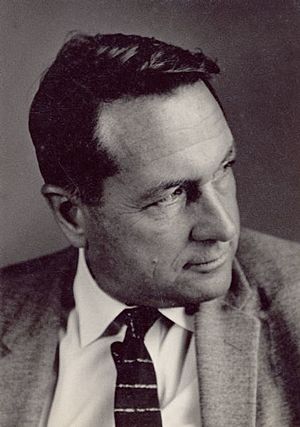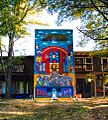Highlander Research and Education Center facts for kids
The Highlander Research and Education Center, once known as the Highlander Folk School, is a special place in New Market, Tennessee. It's like a school where people learn how to become leaders for social justice. This means they learn how to make things fairer and better for everyone in society.
It was started in 1932 by a man named Myles Horton, along with educator Don West and minister James A. Dombrowski. The first location was in Summerfield, Tennessee.

Highlander helps train leaders who want to make positive changes in the Southern United States, the Appalachian region, and even around the world. In its early days, Highlander helped people during the labor movement, which was about workers getting fair treatment.
Later, in the 1950s, Highlander played a very important part in the American Civil Rights Movement. This movement worked to end unfair treatment and segregation against Black people. Highlander trained many famous civil rights leaders. For example, Rosa Parks attended Highlander before her brave act on a Montgomery bus. Other leaders like Martin Luther King Jr., John Lewis, and Septima Clark also received training there.
Because of its work in the Civil Rights Movement, the state of Tennessee closed the school in 1961. But the staff quickly reorganized! They moved to Knoxville, Tennessee, and started again as the "Highlander Research and Education Center." Since 1971, Highlander has been in its current home in New Market, Tennessee.
Contents
Highlander's History
Starting Years and Early Focus
The Highlander Folk School began in 1932 in Grundy County, Tennessee. This was during the Great Depression, a time when many people in the United States were struggling. Workers often faced big challenges when they tried to form unions to improve their working conditions.
Myles Horton and the other founders wanted Highlander to be a place where leaders could learn how to help people in rural areas and factories. They also wanted to protect the special culture of the mountains. Horton was inspired by adult education schools he saw in Denmark.
During the 1930s and 1940s, Highlander mainly focused on teaching workers and training people to organize unions. From 1938 to 1953, Highlander also ran a free nursery school for local children. This helped build good relationships with families in the area.
Helping the Civil Rights Movement
In the 1950s, Highlander shifted its focus to the growing issues of civil rights and ending segregation. A key person during this time was John Beauchamp Thompson, a minister who helped raise money for the school.
Highlander worked with a leader named Esau Jenkins to create a program that taught Black people how to read. This was important because, in some places, people had to pass a reading test to register to vote. These "Citizenship Education Schools," led by Septima Clark, helped thousands of Black people register to vote across the South. Later, this program was moved to the Southern Christian Leadership Conference (SCLC), led by Martin Luther King Jr., because Highlander was being threatened with closure.
Many important civil rights activists visited Highlander. John Lewis shared that he had his first meal in a place where Black and white people ate together at Highlander. He also said that Rosa Parks saw Black and white educators working together as equals there. This experience helped inspire her to take her stand on the bus.
The famous civil rights song, "We Shall Overcome", was adapted from a gospel song by Highlander's music director, Zilphia Horton. She heard it from striking tobacco workers. Later, Guy Carawan, who became Highlander's music director, taught the song to the Student Nonviolent Coordinating Committee (SNCC). This song has now become a symbol of movements for change all over the world.
Facing Challenges and Moving Forward
Highlander has faced many challenges and attacks since it began. In the late 1950s, some newspapers in the South claimed that Highlander was causing racial problems. Some people even accused Highlander of being involved with communism.
In 1961, the state of Tennessee officially closed Highlander's original school. They took its land and property. However, the Highlander staff quickly started again. They renamed themselves the Highlander Research and Education Center and moved to Knoxville, Tennessee. In 1971, they moved to their current location in New Market, Tennessee.
Focus on Appalachian Issues
In the 1960s and 1970s, Highlander began to focus on the health and safety of workers in the coal mines of Appalachia. Its leaders helped start the region's environmental justice movement, which works to make sure everyone has a healthy environment, no matter where they live. Highlander also helped study who owned land in Appalachia.
In the 1980s and 1990s, Highlander expanded its work to include broader environmental issues and challenges related to globalization. They continued to help develop leaders in communities that didn't have many resources. Starting in the 1990s, Highlander also became involved in LGBT issues, supporting fairness for all people. Helping young people organize is another important part of Highlander's work.
Learning from Experience: Research and Education
Highlander often uses a special way of learning called "community-led" or "participatory research." This means that people in the community help plan and carry out research projects. Myles Horton believed that communities could learn a lot from their own experiences.
In the 1970s, Highlander helped communities study complex topics like environmental risks and who owned land. This work helps people with similar interests connect and talk to each other.
Highlander also uses "popular education" strategies. This way of teaching uses the experiences and knowledge of a group of people. It helps everyone become a leader and shows that everyone's experiences are valuable.
Highlander Since 2000
Today, Highlander focuses on issues like democratic participation (making sure everyone has a say) and economic justice (making sure everyone has fair economic opportunities). They work with young people, immigrants from Latin America, African Americans, LGBT people, and poor white people. Their work with immigrants helps immigrant and refugee leaders at local and national levels.
In 2014, the original school building in Grundy County was listed as one of Tennessee's most "endangered" historic sites.
On March 29, 2019, a fire destroyed one of Highlander's buildings. No one was hurt, but many important historical documents and items were lost. Investigators looked into the cause of the fire.
Highlander Directors
Here are the people who have led Highlander:
- Myles Horton, 1932–1969
- Frank T. Adams, 1970–1973
- Mike Clark, 1973–1978
- Helen Matthews Lewis, 1978–79
- Mike Clark, 1979–1984
- Hubert E. Sapp, 1984–1993
- John Gaventa, 1993–1996
- Jim Sessions, 1996–1999
- Suzanne Pharr, 1999–2003
- Mónica Hernández and Tami Newman, interim co-directors 2004–2005
- Pam McMichael, interim director, 2005; director 2006–2016
- Ash-Lee Woodard Henderson and Allyn Maxfield Steele, co-directors since 2016
Images for kids
See also
- Continuing education
- May Justus
- Rand School of Social Science (1906), New York
- Work People's College (1907), Minnesota
- Brookwood Labor College (1921), New York
- New York Workers School (1923)
- New Workers School (1929)
- Jefferson School of Social Science (1944)
- Highlander School
- Commonwealth College (Arkansas) (1923-1940)
- Southern Appalachian Labor School (since 1977)
- San Francisco Workers' School (1934)
- California Labor School (formerly Tom Mooney Labor School) (1942)
- Appalshop (1969), Kentucky




